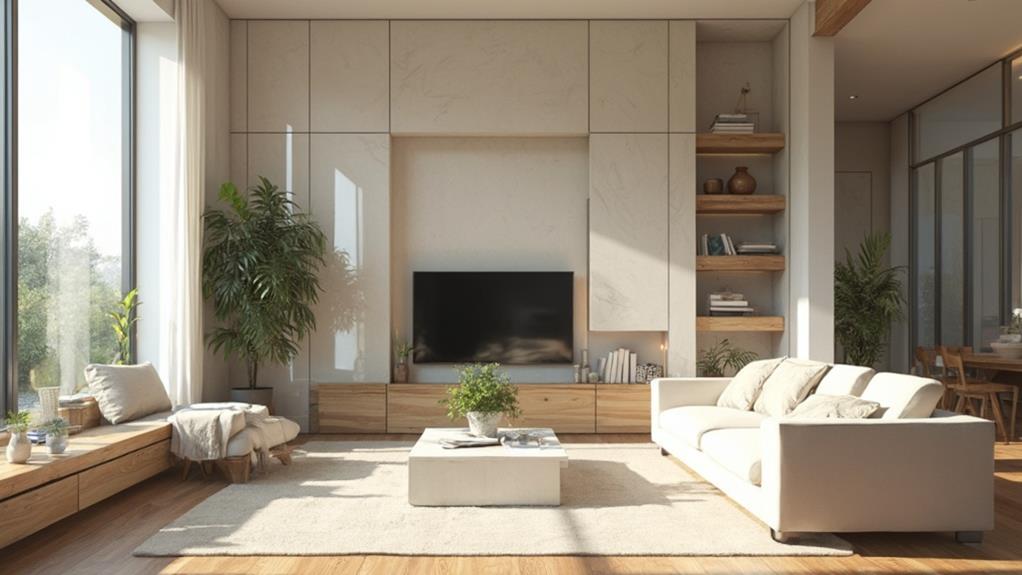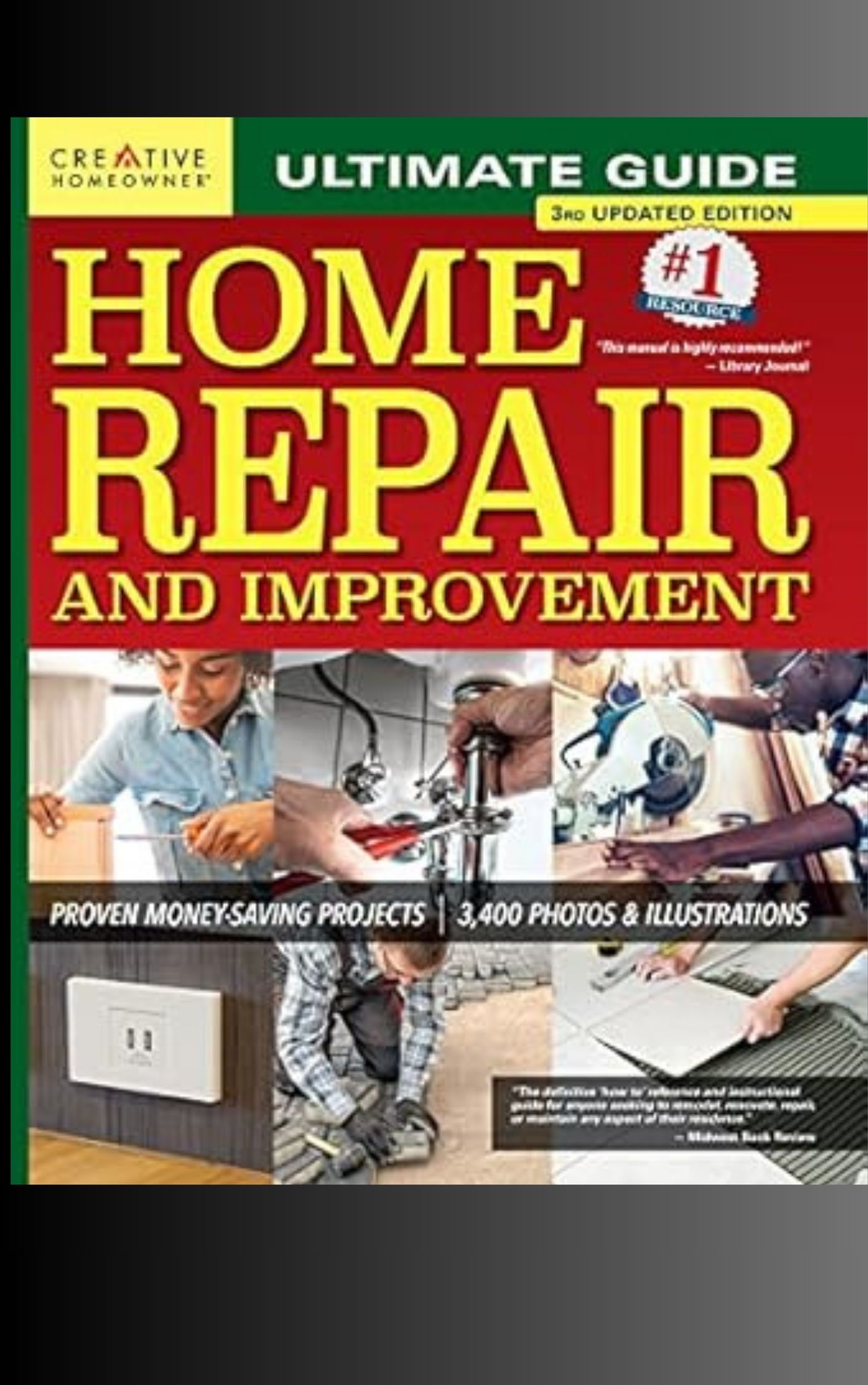Creating a low-maintenance home through smart renovation choices involves strategic planning and material selection. Key areas to focus on include durable flooring options like luxury vinyl plank or porcelain tile, low-maintenance exterior materials such as fiber cement siding and metal roofing, and integration of smart home technology for improved efficiency. Easy-clean kitchen designs featuring non-porous countertops and seamless backsplashes, along with simplified bathroom layouts, contribute to reduced upkeep. Efficient HVAC systems with programmable thermostats and air purification capabilities enhance comfort while minimizing maintenance. By implementing these renovation strategies, homeowners can significantly reduce the time and effort required for home upkeep. Exploring additional aspects can further streamline home management.
Durable Flooring Options
Durability stands as a paramount consideration when selecting flooring for a smart home renovation. Homeowners seeking long-lasting, low-maintenance options have several high-quality choices available.
Luxury vinyl plank (LVP) flooring offers exceptional durability, water resistance, and a wide range of aesthetic options that mimic natural wood or stone. Its easy installation and minimal upkeep make it an increasingly popular choice for busy households.
Porcelain tile is another excellent option, known for its strength, scratch resistance, and ability to withstand heavy foot traffic. It's ideal for high-moisture areas like bathrooms and kitchens, and its versatility in design allows for various styles and patterns. For those preferring a warmer feel underfoot, engineered hardwood combines the beauty of natural wood with enhanced stability and moisture resistance.
Polished concrete floors have gained popularity in modern homes, offering a sleek, industrial look while being incredibly durable and easy to maintain. For basements or areas prone to moisture, epoxy flooring provides a seamless, waterproof surface that's both robust and customizable in appearance. These durable flooring options not only enhance a home's functionality but also contribute to its long-term value and aesthetic appeal.
Low-Maintenance Exterior Materials
When considering a smart home renovation, what materials can homeowners choose for the exterior to minimize maintenance requirements? Several options exist that offer durability and low upkeep.
Fiber cement siding is a popular choice, combining the look of wood with superior resistance to rot, pests, and fire. It requires minimal maintenance and can last up to 50 years.
Vinyl siding is another low-maintenance option, offering affordability and easy cleaning with just occasional power washing.
For roofing, metal stands out as a long-lasting, low-maintenance material. It resists weather damage, reflects heat, and can last over 50 years with proper installation.
Slate and synthetic slate roofing also offer exceptional durability and minimal upkeep.
Composite decking materials provide the appearance of wood without the need for regular staining or sealing. These materials resist fading, scratching, and mold growth, requiring only periodic cleaning.
Low-maintenance windows, such as vinyl or fiberglass frames with double or triple-pane glass, offer energy efficiency and durability without the need for painting or frequent repairs. These choices can significantly reduce exterior maintenance tasks and associated costs over time.
Smart Home Technology Integration
The modern home is rapidly evolving into a hub of interconnected devices and systems. Smart home technology integration offers homeowners unprecedented control, efficiency, and convenience. By incorporating these innovations during renovation, homeowners can create a low-maintenance living environment that adapts to their needs.
Key areas for smart technology integration include lighting, climate control, security, and energy management. Smart lighting systems allow for remote control and scheduling, reducing energy waste. Intelligent thermostats learn occupants' preferences and adjust temperatures accordingly, optimizing comfort and efficiency.
Advanced security systems with connected cameras, smart locks, and motion sensors provide enhanced protection and peace of mind. Energy management systems monitor and control power consumption, identifying areas for improvement and potential savings. Smart appliances can be programmed to run during off-peak hours, further reducing energy costs. Voice-activated assistants can seamlessly integrate these systems, allowing for hands-free control of various home functions.
When planning smart home technology integration, it's crucial to consider future compatibility and scalability. Opting for open-standard protocols ensures that different devices can communicate effectively, creating a cohesive and efficient smart home ecosystem that evolves with technological advancements.
Easy-Clean Kitchen Designs
How can a kitchen be designed to minimize cleaning time and effort? The key lies in selecting materials and layouts that inherently resist dirt and are simple to wipe down. Opt for non-porous countertops like quartz or sealed granite, which don't absorb spills and can be cleaned with a quick swipe. Install seamless backsplashes to eliminate grout lines that trap grime. Choose flat-front cabinets without ornate details that collect dust.
Flooring should be durable and easy to mop, such as luxury vinyl plank or large-format tiles with minimal grout lines. For appliances, select models with fingerprint-resistant finishes and self-cleaning features. Incorporate pull-out trash and recycling bins to contain messes. Install a touchless faucet to reduce water spots and handle grime.
Design with clutter reduction in mind by including ample storage solutions like deep drawers, pull-out pantry shelves, and corner cabinet organizers. This keeps countertops clear and easier to clean. Lastly, good lighting and a light color palette can help spot dirt quickly, making regular cleaning more efficient and less time-consuming.
Bathroom Renovation for Simplicity
Simplicity in bathroom design can transform a cluttered, high-maintenance space into a serene and easily manageable oasis. To achieve this, consider installing a wall-mounted toilet, which eliminates hard-to-clean nooks and crannies around the base. Opt for a floating vanity to simplify floor cleaning and create an illusion of more space.
Choose large-format tiles for walls and floors to minimize grout lines, reducing the need for frequent scrubbing. Seamless shower enclosures with frameless glass doors not only look sleek but are also easier to keep clean than traditional shower curtains. For fixtures, select models with smooth, easy-to-wipe surfaces and avoid intricate designs that trap dust and grime.
Adequate storage is crucial for maintaining a clutter-free bathroom. Incorporate built-in niches in shower walls for toiletries and install recessed medicine cabinets for additional storage without compromising floor space. Choose materials resistant to moisture and mildew, such as porcelain tiles and solid surface countertops, to prevent long-term maintenance issues. By focusing on these elements, you can create a bathroom that not only looks elegant but also requires minimal upkeep, saving time and effort in your daily routine.
Efficient HVAC Systems
With rising energy costs and growing environmental concerns, efficient HVAC systems have become a cornerstone of smart home renovations. These systems not only reduce energy consumption but also enhance comfort and air quality while minimizing maintenance requirements.
Modern HVAC solutions incorporate advanced technologies like programmable thermostats and zoning systems, allowing homeowners to customize temperatures for different areas of the house. This targeted approach eliminates energy waste and reduces strain on the system.
High-efficiency heat pumps and variable-speed air handlers provide precise temperature control and improved humidity management, contributing to a more comfortable living environment.
Smart HVAC systems equipped with IoT connectivity enable remote monitoring and control, facilitating proactive maintenance and early detection of potential issues. This feature can significantly extend the system's lifespan and prevent costly breakdowns.
Additionally, energy-recovery ventilators (ERVs) and air purification systems integrated into HVAC units improve indoor air quality by filtering pollutants and maintaining proper ventilation.
When selecting an efficient HVAC system, consider factors such as SEER ratings, ENERGY STAR certification, and compatibility with smart home ecosystems. Properly sized and installed systems ensure optimal performance and longevity, making them a wise investment for low-maintenance, energy-efficient homes.
Landscaping for Minimal Upkeep
Creating a low-maintenance landscape is a key element of smart home renovations, offering both aesthetic appeal and practical benefits. To achieve this, homeowners should focus on selecting native plants adapted to local climate conditions, reducing the need for frequent watering and special care. Incorporating drought-resistant plants and xeriscaping techniques can further minimize water consumption and maintenance requirements.
Hardscaping elements like stone pathways, patios, and retaining walls can reduce the amount of grass that needs regular mowing and upkeep. Installing an efficient irrigation system with smart controllers can automate watering schedules based on weather conditions, ensuring optimal water usage. Mulching garden beds helps retain soil moisture, suppress weed growth, and reduce the need for frequent watering.
Consider replacing high-maintenance lawns with alternatives such as artificial turf or groundcover plants that require less mowing and fertilization. Strategically placed trees can provide natural shade, reducing cooling costs for the home while adding visual interest to the landscape. By implementing these strategies, homeowners can create an attractive outdoor space that demands minimal time and effort to maintain, aligning with the overall goal of a low-maintenance home renovation.
Storage Solutions for Organization
Effective storage solutions are paramount in smart home renovations, enhancing organization and maximizing space utilization. Implementing built-in cabinetry, custom closet systems, and multifunctional furniture can significantly reduce clutter and improve daily living efficiency.
Consider floor-to-ceiling shelving units in living areas and bedrooms to capitalize on vertical space, while under-stair storage can transform often-wasted areas into valuable compartments.
In the kitchen, pull-out pantry shelves, lazy Susans, and drawer organizers optimize cabinet space and accessibility. Incorporate a mudroom or entryway storage system with designated areas for shoes, coats, and everyday items to maintain order and prevent clutter from spreading throughout the home.
Utilize wall-mounted storage in garages and basements to keep tools and seasonal items off the floor and easily accessible.
For smaller homes, Murphy beds, fold-down desks, and hidden storage compartments in furniture pieces can maximize living space without sacrificing functionality. Lastly, consider digital storage solutions for documents and media to minimize physical storage needs and streamline home organization. By integrating these storage solutions, homeowners can create a more organized, efficient, and low-maintenance living environment.
Frequently Asked Questions
How Much Does a Typical Low-Maintenance Home Renovation Cost?
The cost of a typical low-maintenance home renovation varies widely, ranging from $20,000 to $100,000 or more. Factors influencing the price include the scope of work, materials chosen, and local labor costs. Professional consultation is recommended for accurate estimates.
Can Low-Maintenance Renovations Increase My Home's Resale Value?
Low-maintenance renovations can indeed boost resale value. While initial costs may vary, long-term benefits are clear. Energy-efficient upgrades, durable materials, and smart home features attract buyers, potentially increasing your home's market appeal and overall worth.
What Are the Best Low-Maintenance Paint Options for Interior Walls?
For low-maintenance interior walls, consider premium acrylic latex paints with a satin or semi-gloss finish. These options are durable, easy to clean, and resist stains. Look for paints labeled as "washable" or "scrubbable" for optimal performance and longevity.
How Long Does a Complete Low-Maintenance Home Renovation Typically Take?
Like Rome, a complete low-maintenance home renovation isn't built in a day. Typically, it spans 3-6 months, depending on the scope, complexity, and size of the project. Factors such as permits, materials, and contractor availability influence the timeline.
Are There Tax Incentives for Implementing Energy-Efficient, Low-Maintenance Home Improvements?
Yes, there are often tax incentives available for energy-efficient home improvements. These may include credits for installing solar panels, energy-efficient windows, and upgraded insulation. Check with your local tax authority or a tax professional for specific details.
Conclusion
Smart renovation choices can significantly reduce the long-term maintenance requirements of a home. By selecting durable materials, integrating technology, and designing for efficiency, homeowners can create spaces that are both beautiful and easy to maintain. But what if the real luxury isn't just in the aesthetics, but in the time saved? Thoughtful renovations that prioritize low-maintenance features not only enhance property value but also provide homeowners with the priceless commodity of more free time to enjoy their living spaces.

